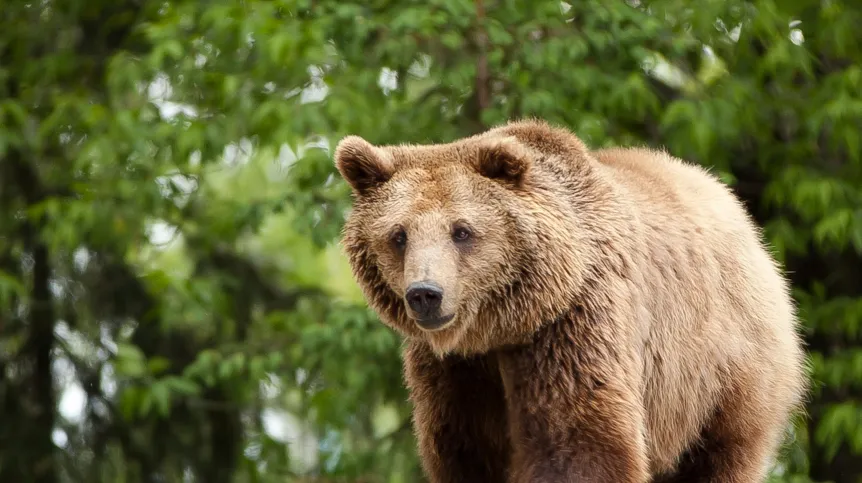
According to popular belief, any bear that smells honey cannot resist and will break into the apiary. Scientists have found that this is not true. They used DNA samples taken at the 'crime' sites to show that two thirds of the bears in the north-eastern Carpathians do not break into hives, despite the fact that many hives are still not properly secured.
The starting point for the research of scientists from Poland, Spain and Germany was the case of apiary destruction by a bear in early April 2014.
In a small, Carpathian village surrounded by forest, 100 kilometres northwest of the Kremenaros tripoint on the borders of Poland, Slovakia and Ukraine, a beekeeper went to check his hives after the winter season.
He had been running an apiary for more than three decades, and despite living in a region inhabited by brown bears, he had never experienced any damage from them. He had also never properly secured his hives against bears. Considering that in a region of 4,700 km2, bears cause an average of 52 damages per year, most of them (92%) in apiaries, the beekeeper had been lucky - until that day. He found 15 destroyed hives in his small apiary. A few days earlier, a very similar incident occurred in another village just five kilometres away.
Shortly after the case was reported to the Regional Directorate for Environmental Protection, a team of scientists from the Institute of Nature Conservation of the Polish Academy of Sciences arrived equipped with gloves, vials and a portable fridge. They were looking for biological material - mainly hair, but also faeces left by bears that were probably involved in the event. The researchers carefully examined the destroyed hives, frames, fences and the surrounding area. Like CSI, they secured all biological samples and transported them to their lab in Kraków. They extracted DNA in order to identify the individuals responsible for destroying the hives. They determined that the same female with two cubs had been involved in both apiary break-ins. Three years later, she was identified as a culprit in two similar incidents.
Over the course of four years, a team of researchers from the Institute of Nature Conservation PAS and employees of the Regional Directorate for Environmental Protection in Rzeszów inspected 209 damages reported as presumably caused by bears, and collected and analysed 146 biological samples. The team also conducted a year-long systematic genetic study of the entire population, collecting samples of hair and faeces in the range of this species in Podkarpacie. The researchers then used complex statistical models to provide the first reliable estimates of the number of bears living in the Polish Eastern Carpathians. This is not an easy task as these animals are secretive, rare and travel long distances. However, scientists knew how to provoke bears to rub against certain trees and leave fur. Thanks to special hair traps with an attractive smell for bears, they collected 169 hair samples.
Using the genetic information found in the collected hair and faeces samples, the team estimated that between 45 and 115 bears inhabited the study area.
They found that out of an average of 72 bears living in the Polish Eastern Carpathians, only one third break into apiaries.
They also found that not all individuals were equally often identified at the damage sites.
First author of the study, Teresa Berezowska-Cnota from the Institute of Nature Conservation PAS, said: “The common view is that if someone behaved badly once, they will behave similarly in the future. We have shown that in the case of brown bears this is rather an exception.”
Among the bears breaking into apiaries, about 33 percent were repeat offenders. Importantly, the results of the study suggest that the majority of animals did not cause any damage.
The authors of the analyses emphasise that their study is important from the point of view of nature conservation and human-wild animal conflict management.
Nuria Selva from the Institute of Nature Conservation PAS, the study co-author and project leader, believes that in order to effectively resolve conflicts between humans and wild animals, both sides should be addressed. She said: “On one side we have people. We still have a long way to go in terms of damage prevention. Most apiaries and livestock are not properly secured in areas populated or re-colonised by large predators, which creates a potential for conflicts.
“On the other side there are wild animals Without identifying the specific individuals involved in incidents and understanding their behaviour, conflicts cannot really be resolved.”
The scientists also point out that understanding individual aspects of conflict behaviour through studies on large space-time scales, covering the entire population, should be a priority in applied ecology and nature conservation.
The study was published in the Journal of Applied Ecology (DOI: 10.1111/1365-2664.14388). Financed by the Polish National Science Centre, the project is the result of cooperation between the Institute of Nature Conservation of the Polish Academy of Sciences, Estacion Biologica de Donana CSIC, German Centre for Integrative Biodiversity Research, the Regional Directorate for Environmental Protection in Rzeszów and the Bieszczady and Magura National Parks. (PAP)
PAP - Science in Poland
zan/ bar/ kap/
tr. RL













